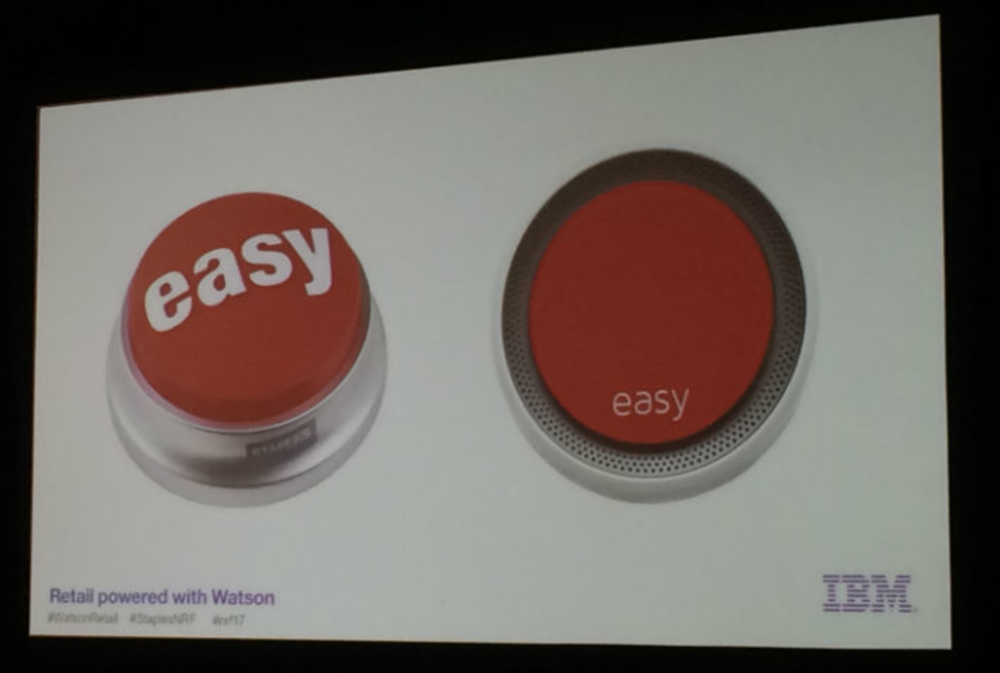When people think of Staples, they often think of the office supplies retailer’s consumer-facing business. A go-to source during the back-to-school season, Staples sells everything from notebooks and pens to printers and ink cartridges.
But at Retail’s Big Show in New York, the National Retail Federation’s annual convention and expo, Staples’ head of growth and applied innovation Ryan Bartley said the company has a B2B component, too—one that offers print and marketing services to Fortune 100 giants and small and mid-sized businesses, alike.
Now, the retailer is introducing an easier way for B2B customers to order what they need when they need it—a concept it developed by partnering with IBM Watson and putting a new spin on an old marketing shtick: the Easy Button.
Staples’ marketing team debuted the Easy Button in 2005 and continued to feature it throughout the years in TV commercials and as a physical office décor item.
“It represented Staples’ brand promise of being easy to do business with,” Bartley said during a session moderated by IBM’s VP and GM of global consumer industry Stephen Laughlin.
But it wasn’t until early 2016 that the idea of pressing a button to get needed office supplies went from fantasy to reality. Bartley and his team decided to create a working Easy Button after spending “thousands” of hours talking to customers and testing different product models.
“You’ll never be able to deliver something of significant value sitting in your office….You have to go out and talk to your customers,” he said.
Here’s how the new Easy Button works: Powered by IBM Watson’s API and the cognitive platform’s natural language processing and machine learning capabilities, the Easy Button is a voice-activated, on-demand ordering system that lets customers order the Staples products that they need via voice, text, email, messaging apps, or mobile app.
The Easy Button has customer service features—such as the ability to track an order or review rewards—and leverages machine learning and Staples’ personalization APIs to grow smarter over time. So when a customer orders “blue pens,” for instance, the Easy Button knows which brand of blue pens the customer wants based on previous purchases. Or, if a customer hasn’t ordered blue pens in the past, it can make recommendations. If the Easy Button doesn’t understand a customer’s request, it will connect the customer to a live service agent and then ingest that conversation to better understand his request in the future, an IBM case study reports.
“Now, we’re at a place where the Easy Button represents truly anywhere and everywhere commerce,” Bartley said.
In addition, the Easy Button is meant to lighten the load of office administrators, Bartley said, and serve as “an assistant’s assistant” by learning how to respond to commonly asked questions. For instance, instead of having employees constantly ask the office administrator for the WiFi password, he said, Easy Button can learn the password and relay it back to the inquiring party.
Although Bartley wants to have Easy Buttons available to every office in the United States, he said that Staples is currently in the beta phase of this project and will be offering it to 100 customers to “test and fine tune” the product.
The aforementioned IBM case study states that the Easy Button is anticipated to increase order frequency and size, as well as improve service scores. But, perhaps, one of the biggest benefits for Staples is having the Easy Button take the guesswork out of customers’ wants and desires. As Bartley put it, “I don’t have to think that hard about what the customer really needs.” Thanks to the Easy Button customers now tell him directly.








